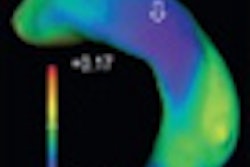Sunday, November 28 | 11:55 a.m.-12:05 p.m. | SSA10-08 | Room E353B
Researchers from the University of Chicago will describe the potential for their prototype computer-aided detection (CAD) software in prostate MRI in this Sunday scientific session.Despite its limitations, multiparametric MRI (including T2-weighted imaging, diffusion-weighted imaging, dynamic contrast-enhanced MRI, and MR spectroscopy) is currently the best imaging modality for imaging the prostate and prostate cancer, according to presenter Aytekin Oto, MD. But the burden of analyzing a huge amount of data can be overwhelming for a single radiologist.
As a result, the researchers sought to develop and test prototype CAD software that allowed for analysis of all MRI parameters using a Bayesian neural network. They found that combining multiple quantitative parameters improves upon the performance of any single parameter in predicting tumor Gleason score.
Offering a "virtual biopsy" method, computerized analysis of prostate MRI can potentially integrate multiprotocol MR image information and aid in clinical decision making, according to Oto.
"We expect CAD will allow a more standardized and automated analysis of multiparametric MR data, thereby improving cancer detection results and the reproducibility of the interpretation of MRI data," Oto told AuntMinnie.com. "Accurate localization information using CAD-assisted multiparametric MRI may be used to improve the yield and accuracy of prostate biopsies either by performing biopsies under MR guidance or using real-time [transrectal ultrasound] guidance with fusion of the information from multiparametric MRI."




.fFmgij6Hin.png?auto=compress%2Cformat&fit=crop&h=100&q=70&w=100)




.fFmgij6Hin.png?auto=compress%2Cformat&fit=crop&h=167&q=70&w=250)











